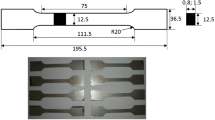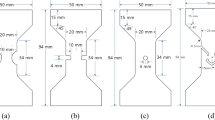Abstract
Features of sheared edges are predicted based on material properties of Zircaloy obtained from the tensile test and ductile fracture model such as the Gurson-Tvergaard-Needleman (GTN) and Johnson-Cook models. The sheared edges formations are numerically analyzed in each ductile model. An appropriate ductile fracture model is selected to study the relative depth of sheared edges with respect to process parameters. The tendency of failure parameters that are affected by sheared edges and fracture duration is investigated. We applied changes on parameters of failure models to show that the punch force curve and the ratio of characteristic lengths could be coincided, which led us to conclude that the GTN and Johnson-Cook models are equivalent. In the Johnson-Cook model, however, the characteristic length of the sheared edges does not change as each failure parameter reaches a critical value. Hence, the FE prediction model for forming defects is developed using the GTN failure model. Finally, the characteristic length of sheared edges have been measured using the FE prediction model for shearing process parameters such as punch velocities, clearance, and tool wear. Our results showed that the punch-die clearance is the most significant factor that affects forming defects when compared to other factors.
Similar content being viewed by others
References
H. J. Kunz and K. N. Song, Siemens/KWU Work-Report, U6 312/87/e326 (1987).
S. H. Lee, K. N. Song, and J. Y. Kim, J. Mech. Sci. Technol. 21, 1191 (2007).
S. B. Lee, K. N. Song, and Y. W. Kim, J. Mech. Sci. Technol. 22, 2024 (2008).
K. N. Song and S. S. Kim, J. Laser Micro/Nanoengineering 2, 95 (2007).
K. N. Song, S. H. Lee, S. B. Lee, J. J. Lee, and G. J. Park, Trans. Korean Society of Mech Eng. 34, 1175 (2010).
T. M. Chang and H. W. Swift, J. Inst. Metal. 78, 393 (1950).
E. Taupin, J. Breitling, W.-T. Wu, and T. Altan, J. Mat. Proc. Technol. 59, 68 (1996).
D. C. Ko and B. M. Kim, Int. J. Mach. Tools. Manuf. 40, 1329 (1997).
L. Ming, Int. J. Mech. Sci. 42, 889 (2000).
V. Lemiale, J. Chambert, and P. Picart, J. Mat. Process Technol. 209, 2723 (2009).
S. Yu, X. L. Xie, J. Zhang, and Z. Zhao, J. Mat. Process Technol. 187, 169 (2007).
M. Rachik, J. M. Roelandt, and A. Maillard, J. Mat. Process Technol. 128, 256 (2002).
R. Hambli, J. Mat. Proc. Technol. 116, 252 (2001).
C. Husson, J. P. M. Correia, L. Daridon, and S. Ahzi, J. Mat. Process. Technol. 99, 74 (2008).
S. P. Lo, D. Y. Chang, and Y. Y. Lin, J. Mat. Process. Technol. 194, 126 (2007).
N. Hatanaka, K. Yamaguchi, and N. Takakura, J. Mat. Process. Technol. 139, 64 (2003).
W. G. Lee and J. P. Jung, Korean J. Met. Mater 49, 237 (2011).
A. L. Gurson, J. Eng. Mater. Technol. 99, 2 (1977).
V. Tvergaard, Int. J. Frac. 17, 389 (1981).
V. Tvergaard and A. Needleman, Acta Metall. 32, 157 (1984).
M. Gologanu, J. Leblond, and J. Devaux, J. Mech. Phys. Solids 41, 1723 (1993).
M. Gologanu, J. Leblond, G. Perrin, and J. Devaux, Springer Verlag (1997).
G. R. Johnson and W. H. Cook, Eng. Fract. Mech. 21, 31 (1985).
J. Lemaitre, J. Eng. Mater. Technol. 107, 83 (1985).
G. Rousselier, Nuclear Engineering and Design 105, 97 (1987).
ABAQUS User’s Manual, Version 6.9, Dassault Systemes Simulia Corp., Providence, RI, USA (2009).
A. Needleman and V. Tvergaard, Brown University Report, Division of Engineering (1985).
A. Franklin, J. Iron Steel Inst 207, 181 (1969).
Author information
Authors and Affiliations
Corresponding author
Rights and permissions
About this article
Cite this article
Wang, J., Kim, N. & Lee, H. Ductile fracture model in the shearing process of zircaloy sheet for nuclear fuel spacer grids. Met. Mater. Int. 18, 303–316 (2012). https://doi.org/10.1007/s12540-012-2014-6
Received:
Accepted:
Published:
Issue Date:
DOI: https://doi.org/10.1007/s12540-012-2014-6




